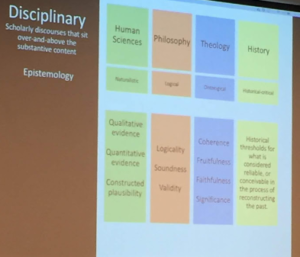A Knowledge Rich Curriculum with 20:20 vision
06 November, 2018, Neil McKain
Last month I was fortunate to attend the 20:20 RE conference in Crewe. The conference title was Practice, Policy and Powerful Knowledge. Every single session I went to was excellent. The variety on offer was outstanding – including a discussion of Brexit and RE, Understanding the non-religious in the classroom, and two brilliant keynotes from Joyce Miller and Mary Myatt. But the one session that has stuck with me has been Richard Kueh’s on curriculum design. Entitled The Problem of Pedagogy: Substantive, Disciplinary and Knowledge in RE Richard really got to the heart of the most pressing question surely facing any RE teacher – what exactly am I meant to teach?
Richard’s thesis was that RE pedagogy has often been preoccupied with the instrumental nature of the subject, and therefore has treated the knowledge taught as being illustrational rather than substantive. A second string of his argument was that too often those designing RE curriculums and syllabuses have shown little awareness of the academic disciplinary approaches underpinning the subject. The photograph from the talk (see below) explains the four academic disciplines that Richard believes underpin RE. I will attempt to summarise some of what Richard said about these disciplines before giving an example from my own Year 9 SOW to see a similar approach in practice.

The ongoing arguments about what to call our subject (RE, RS, Religion and Ethics, Religion, Beliefs and Values, or the Commission on RE suggestion Religion and Worldviews) is a sign of the disciplinary confusion that exists. History teaches students be historians, Geography teaches students to be geographers, RE teaches students to be… what? Part of the answer Richard provided was that RE (sorry, Religion and Worldviews) should teach students how to study what it is they are studying. This will involve them knowing important stuff but also how to approach that stuff. Making this explicit to students is important. At this point a shout out was given to the primary RE-searchers model developed by Rob and Giles Freathy and others.
But what about at secondary? Our students choose their GCSE courses in year 8, but do not start the specified material until year 10. Year 9 is a pre-GCSE year where students are prepared with the knowledge and skills that will support them at KS4.
Year 9 RS therefore begins with a simple question. What is religion? Now I’m sure many year 7 SOW also include this question, but do we revisit it as students’ capacity to understand and deal with complexity grows? This video is an excellent way in and begins by introducing students into the complexity of studying religion from an academic perspective. It highlights American scholar Ben Marcus’s model of the 3 Bs of religion which are useful hooks for students to refer back to during the rest of the year and into their GCSEs.

After dipping our toes into the Human Sciences, the next unit looks at the early History of Christianity. Using Rob Orme’s Knowing Christianity textbook, students explore the historical origins of Christianity and are introduced to key figures such as St Paul and Constantine. Students enjoy the historical arguments as to who of these formative figures had a greater influence on what we understand as Christianity today. Looking at the Council of Nicea and the Nicene Creed provides an opportunity to look at the theological beliefs of Christianity. We take a similar historical approach with Buddhism, which is our second religion at GCSE, but whose history is not on the GCSE syllabus. The question of whether Buddhism is a religion, or whether Siddhartha was rejecting certain aspects of Dharmic religiosity, again leads to much debate and reference back to the 3Bs. Students end the year with a study of inter-faith dialogue and by taking part in a video conference on religion and identity with students in another country. The 3 Bs and the knowledge they have gained from studying the history of two major world religions in depth comes in very useful to help students reflect on what religion is and how it can be studied.
Now I’m not saying this model is unique or perfect. But it perhaps shows what is possible to achieve with KS3 students who will really rise to the challenge of being presented with powerful knowledge and a curriculum designed with a strong disciplinary understanding. If you’d like to find out more please get in touch or you are welcome to come and visit the department.